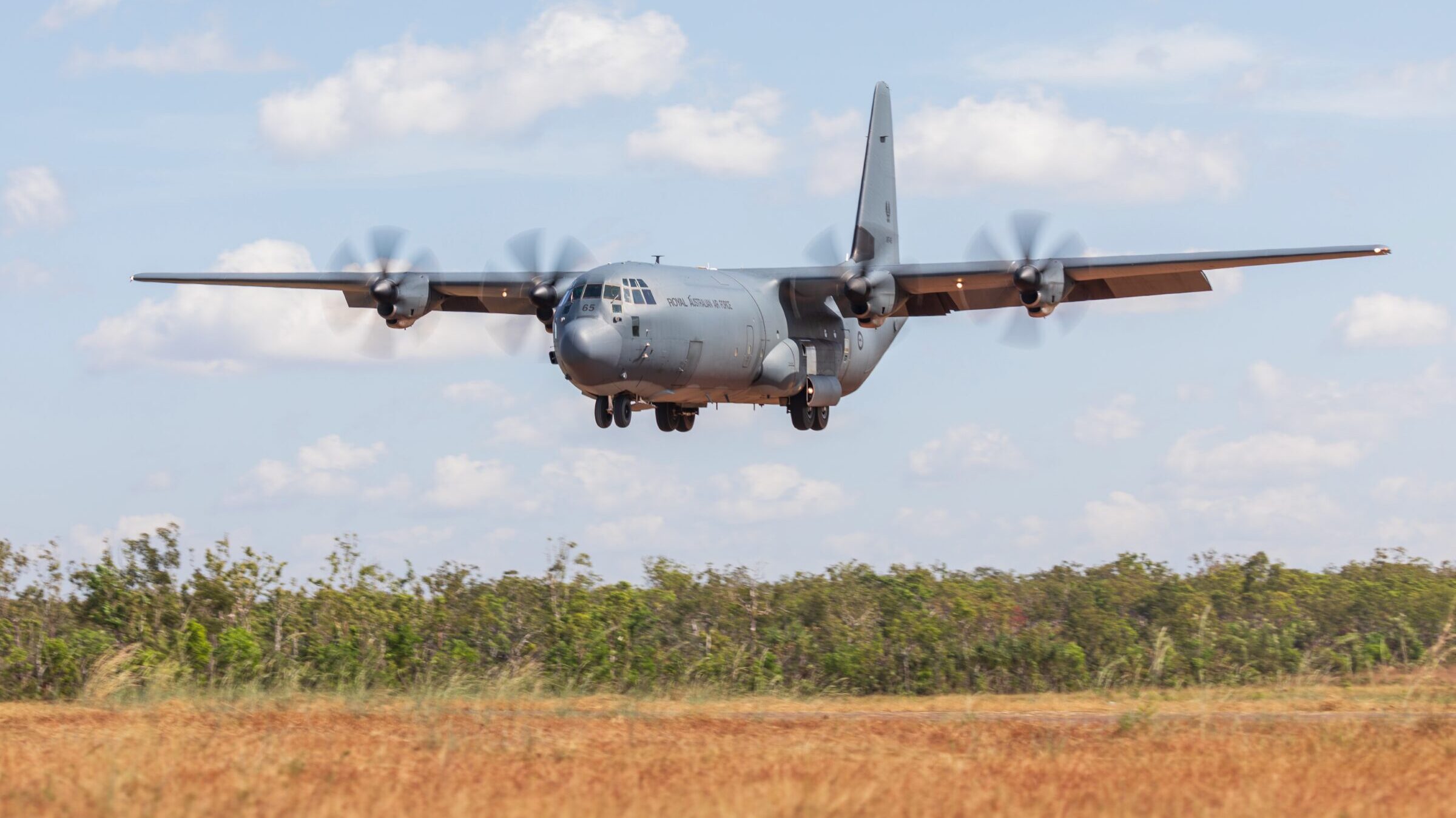
A Royal Australian Air Force C-130J Hercules prepares to land at Mount Bundey Training Area in the Northern Territory, during Exercise Diamond Storm 2022. (LAC Sam Price, RAAF)
MELBOURNE — Companies here bandy the term “sovereign” about when they make announcements, saying they’ve contributed to increased sovereignty by working with smaller Australian companies or by ensuring parts are available or ammunition will be in storage in sufficient quantities.
It’s not just them paying lip service. Australia’s official stance is that the military will will somehow both buy lots of foreign weapons with foreign parts from far-away lands but will also ensure it can maintain “sovereign” capability.
And it makes sense. The incredibly rapid rate at which Russia and Ukraine have gone through artillery shells and missiles, as well as the risks of Australia facing a country like China, which possesses enormous industrial capacity and the increasing ability to project power, demonstrate how this land could be left empty of weapons in a very short time.
Asked at Monday’s Air Chief Symposium here how Australia can realistically and effectively implement the sovereignty policy, Chris Deeble, deputy secretary in charge of the Capability Acquisition and Sustainment Group, acknowledged “It is a vexing problem…. We’re not doing that well at this point in time.”
He knows whereof he speaks. CAS-G, as it’s known, oversees most Australian defense acquisition and Beedle has managed Australian procurement of the F-35, Wedgetail, the KC-30A tanker, and the Collins-class subs. A new defense industrial development strategy is forthcoming, and, he said, “that will guide us in terms of what sovereignty should look like from an industrial perspective. It will state our priorities and the way in which that needs to be done.”
The CAS-G’s head of land systems, Maj. Gen. Andrew Bottrell, offered an outline of how Australia has implemented the sovereignty policy.
“What are the things that are most important. what things do we need to have choice and influence over. That’s what sets the boundaries of sovereignty,” he said.
He gave examples of three recently established facilities — the Rheinmetall Military Vehicle Center in Redbank, Queensland, Hanwha’s center for self-propelled howitzers at Geelong, Victoria, and a Thales’ center at Bendigo, Victoria. “Those three centers are strategic assets for defense, because we can not only introduce the capability but we can sustain them,”
For a glimpse inside the Australian perspective on coping with this, it’s useful to go back to a rare public discussion on Feb. 9 by Defense Minister Richard Marles about the remote US-Australian installation here known as Pine Gap, and two other lesser-known installations, the Joint Geological and Geophysical Research Station and the Learmonth Solar Observatory. Marles explained the essence of the government’s approach to sovereignty this way:
“Australia operates high-tech platforms and capabilities that we could only acquire from our partners and we could never completely build on our own. In the globalized networked world in which we live, this reality – to a greater or lesser degree – is actually true for every country,” Marles said.
“Yet whether our defense assets are developed indigenously, acquired from abroad, or developed in partnership – Australia will always make sovereign, independent decisions as to how they are employed,” he continued. “Because we will not trade sovereignty for capability. To do so would be illusory. For the only point of increased capability is to strengthen sovereignty.
“And most importantly, any decision for Australia to go to war or to use Australian territory or assets in an armed conflict remains solely a decision for the Commonwealth Government of the day.”
Marles’ parliamentary statement made the most clear-cut argument when it dealt with Australia’s commitment to building and operating nuclear attack submarines under the AUKUS agreement between the Lucky Country, the UK and the US.
“The capability decisions we will make in the context of AUKUS are about strengthening our sovereignty, consistent with the principles and frameworks I have outlined today,” he stated. “Some argue that Australia’s reliance on our partners for the acquisition of naval nuclear-propulsion technology gives rise to a dependence that undermines Australia’s sovereignty. Yet the reality is that almost all of Australia’s high-end capability is developed in cooperation with our partners. Submarines are no exception. And that dramatically enhanced capability dramatically enhances our sovereignty.”
Of course, despite how the government may cast it, Australia will depend enormously, as does the UK, on American help to design, build, maintain and operate these advanced weapons. And that is, at its heart, why “sovereignty” is is such a vexing problem for Australia — a nation that can only reach self-sufficiency in defense through help from others.






















